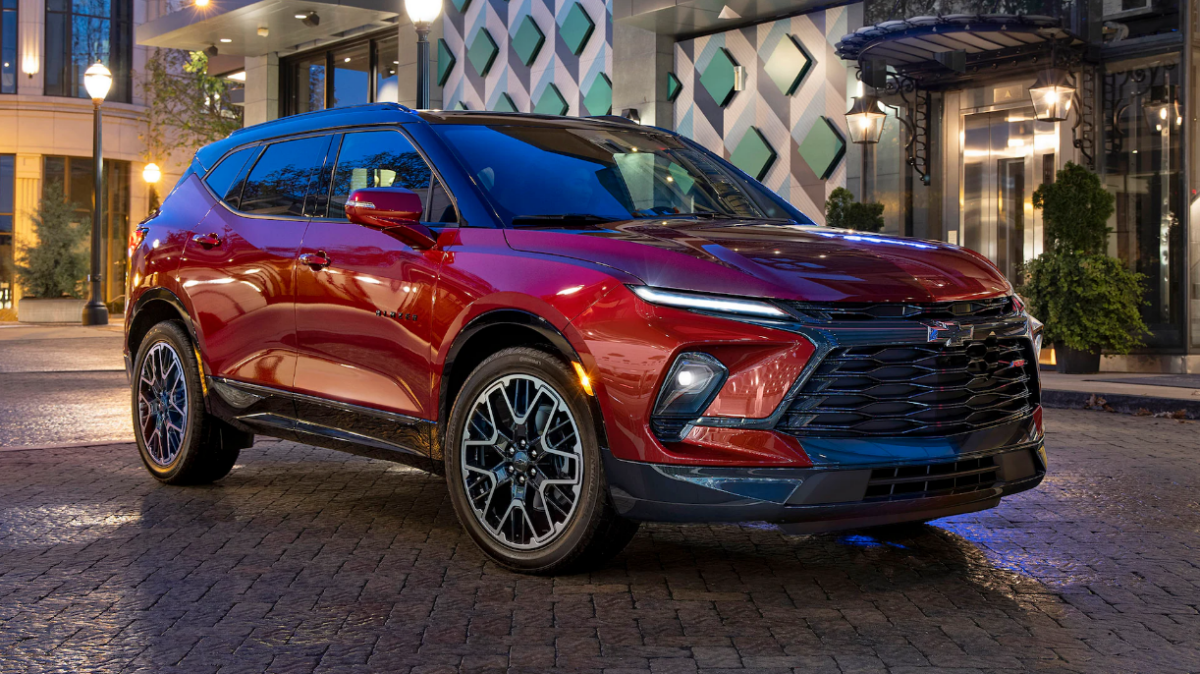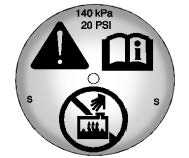2023 Chevrolet Blazer Engine Temperature Control User Manual
The 2023 Chevrolet Blazer has cutting-edge technology for controlling the engine’s temperature, which is a first in the car industry. With a focus on speed and efficiency, this model uses cutting-edge systems to keep the engine temperature in check. The Chevrolet Blazer makes sure that its engine works at its best by using advanced sensors and cooling systems. This makes the engine last longer and be more reliable. This smart temperature control system keeps the engine from getting too hot and also helps the car use less gas and put out less pollution. With its new way of controlling engine temperature, the Chevrolet Blazer puts both performance and environmental duty first, giving drivers peace of mind. The Chevy Blazer 2023 is a perfect mix of power and accuracy, thanks to its smart engineering and top-notch performance.
2023 CHEVROLET BLAZER Review, Price, Features And Mileage (Brochure)
3.6L V6 Engine Only
- Remove the coolant surge tank pressure cap when the cooling system, including the coolant surge tank pressure cap and upper radiator hose, is no longer hot. Turn the pressure cap slowly counterclockwise about one-quarter of a turn. If you hear a hiss, wait for that to stop. This will allow any pressure still left to be vented out the discharge hose.
- Keep turning the pressure cap slowly and remove it.

- Fill the coolant surge tank with the proper mixture to the indicated level mark.
- With the coolant surge tank pressure cap off, start the engine and let it run until you can feel the upper radiator hose getting hot. Watch out for the engine cooling fan. By this time, the coolant level inside the coolant surge tank may be lower. If the level is lower, add more of the proper mixture to the coolant surge tank until the level reaches the indicated level mark.
- Replace the pressure cap tightly.
- Verify coolant level after the engine is shut off and the coolant is cold. If necessary, repeat the coolant fill procedure Steps 1–6. If the coolant still is not at the proper level when the system cools down again, see your dealer.
Caution
If the pressure cap is not tightly installed, coolant loss and engine damage may occur. Be sure the cap is properly and tightly secured.
2.0L L4 Engine Only – Automatic Coolant Service Fill Instructions
If equipped, this feature assists in filling and removing air from the cooling system after the service of components or when coolant is added after being too low.
To activate the fill and air removal process:
- With a cold system, add coolant to the indicated mark on the surge tank.
- Replace the cap on the surge tank.
- Connect the vehicle to a battery charger.
- Turn the ignition to Service Mode. See Ignition Positions 0 192.
- Turn off the air conditioning.
- Set the parking brake.
- At the same time, press the accelerator and the brake for two seconds, then release.
At the end of the cycle, check the coolant level in the surge tank and add coolant if it is low. Turn off the vehicle, allow the Electronic Control Module (ECM) to go to
sleep, for about two minutes, and repeat Steps 4–7. Listen for pump activation and movement of the control valves while watching the level of the coolant in the surge tank. If the tank empties, turn the ignition off, carefully remove the surge tank cap, refill to the indicated mark, and repeat Steps 4–7. The fill and air removal process will run for approximately 10 minutes.
Chevy Blazer Overheating
Engine Overheating
The vehicle has several indicators to warn of the engine overheating. There is an engine coolant temperature gauge on the instrument cluster. See Engine Coolant Temperature Gauge 0 97. The vehicle may also display a message on the Driver Information Center (DIC). If the decision is made not to lift the hood when this warning appears, get service help right away. See Roadside Assistance Program 0 332. If the decision is made to lift the hood, make sure the vehicle is parked on a level surface. Then check to see if the engine cooling fan is running. If the engine is overheating, the fan should be running. If it is not, do not continue to run the engine. Have the vehicle serviced?
Caution
Do not run the engine if there is a leak in the engine cooling system. This can cause a loss of all coolant and can damage the system and vehicle. Have any leaks fixed right away? If Steam Is Coming from the Engine.
Compartment
Warning
Steam and scalding liquids from a hot cooling system are under pressure. Turning the pressure cap, even a little, can cause them to come out at high
Warning
Speed and you could be burned. Never turn the cap when the cooling system, including the pressure cap, is hot. Wait for the cooling system and pressure cap
to cool.
If No Steam Is Coming from the Blazer V6 engine
Compartment
If an engine overheat warning is displayed but no steam can be seen or heard, the problem may not be too serious. Sometimes the engine can get a little too hot when the vehicle:
- Climbs a long hill on a hot day.
- Stops after high-speed driving.
- Idles for long periods in traffic.
If the overheat warning is displayed with no sign of steam:
- Turn the air conditioning off.
- Turn the heater on to the highest temperature and to the highest fan speed. Open the windows as necessary.
- When it is safe to do so, pull off the road, shift to P (Park) or N (Neutral), and let the engine idle. If the engine coolant temperature gauge is no longer in the overheated area, the vehicle can be driven. Continue to drive the vehicle slowly for about 10 minutes. Keep a safe distance from the vehicle in front. If the warning does not come back on, continue to drive normally and have the cooling system checked for proper fill and function. If the warning continues, pull over, stop, and park the vehicle right away. If there is no sign of steam, idle the engine for three minutes while parked. If the warning is still displayed, turn off the engine until it cools down.
Chevy Blazer Engine cooling tips
Maintaining proper engine cooling is crucial for the performance and longevity of your Chevrolet’s engine. Here are some tips to help you keep the engine cooling system in top condition:
- Check Coolant Levels:
- Regularly check the coolant levels in the radiator and reservoir. Ensure it’s at the recommended level and add coolant if necessary.
- Use the Right Coolant:
- Always use the coolant type recommended in your vehicle’s owner’s manual. Mixing different coolant types can lead to issues.
- Inspect for Leaks:
- Periodically inspect the engine and radiator for any signs of coolant leaks. Puddles or stains under the vehicle may indicate a problem.
- Radiator Cap Inspection:
- Check the radiator cap for any signs of wear or damage. A faulty cap can lead to loss of coolant and affect the cooling system’s efficiency.
- Clean Radiator and Cooling Fins:
- Ensure the radiator and cooling fins are clean and free from debris, bugs, or dirt. Use a soft brush or compressed air to clean if necessary.
- Monitor Temperature Gauge:
- Keep an eye on the temperature gauge on your dashboard. If you notice the engine running hotter than usual, investigate the cause promptly.
- Replace Thermostat:
- Replace the thermostat at the recommended intervals or if you notice issues with temperature regulation.
- Inspect Belts and Hoses:
- Check for any visible damage or wear on the drive belts and coolant hoses. Replace them if necessary to prevent leaks or breakdowns.
- Regular Cooling System Flush:
- Follow the manufacturer’s guidelines for flushing the cooling system to remove built-up contaminants. This helps maintain optimal performance.
- Avoid Overheating:
- If your vehicle is running hot, avoid driving it until the issue is resolved. Overheating can lead to severe engine damage.
- Keep A/C in Check:
- The air conditioning system can put extra strain on the engine. Ensure it’s functioning correctly to prevent additional heat stress.
- Check Radiator Fans:
- Ensure radiator fans are working properly. If they’re not functioning, the engine may overheat, especially in traffic or at low speeds.
2023 CHEVROLET BLAZER Review, Price, Features And Mileage (Brochure)
Washer Fluid
What to Use
When windshield washer fluid is needed, be sure to read the manufacturer’s instructions before use. If operating the vehicle in an area where the temperature may fall below freezing, use a fluid that has sufficient protection against freezing.
Adding Washer Fluid Open the cap with the washer symbol on it. Add washer fluid until the tank is full. See Engine Compartment Overview 0 250 for reservoir location.
Open the cap with the washer symbol on it. Add washer fluid until the tank is full. See Engine Compartment Overview 0 250 for reservoir location.
Caution
- Do not use a washer fluid that contains any type of water-repellent coating. This can cause the wiper blades to chatter or skip.
- Do not use engine coolant (antifreeze)in the windshield washer. It can damage the windshield washer system and paint.
- Do not mix water with ready-to-use washer fluid. Water can cause the solution to freeze and damage the washer fluid tank and other parts of the washer system.
- When using concentrated washer fluid, follow the manufacturer’s instructions for adding water.
- Fill the washer fluid tank only three-quarters full when it is very cold. This allows for fluid expansion if freezing occurs, which could damage the tank if it is completely full.
Brakes ( Chevrolet owner’s manual )
Disc brake linings have built-in wear indicators that make a high-pitched warning sound when the brake linings are worn and new linings are needed. The sound can come and go or can be heard all the time when the vehicle is moving, except when applying the brake pedal firmly.
Warning
The brake wear warning sound means that soon the brakes will not work well. That could lead to a crash. When the brake wear warning sound is heard, have the vehicle serviced.
Caution
Continuing to drive with worn-out brake linings could result in costly brake repairs. Some driving conditions or climates can cause a brake squeal when the brakes are first applied, clearing up following several applications.
This does not mean something is wrong with the brakes. Properly torqued wheel nuts are necessary to help prevent brake pulsation. When tires are rotated, inspect brake linings for wear and evenly tighten wheel nuts in the proper sequence to torque specifications. See
Capacities and Specifications 0 326. Brake pads should be replaced as complete axle sets.
Brake Pedal Travel
See your dealer if the brake pedal does not return to normal height, or if there is a rapid increase in pedal travel. This could be a sign that brake service may be required. Replacing Brake System Parts Always replace brake system parts with new, approved replacement parts. If this is not done, the brakes may not work properly. The braking performance can hinge in many ways if the wrong brake parts are installed or if the parts are improperly installed.
FAQ’s
The engine temperature control system in the 2023 Chevrolet Blazer utilizes a combination of components such as the thermostat, radiator, coolant, and cooling fans to regulate and maintain the engine temperature within optimal operating limits.
The normal operating temperature range for the engine of the 2023 Chevrolet Blazer typically falls between 195°F to 220°F (90°C to 104°C), depending on driving conditions and engine load.
The engine temperature gauge on the instrument cluster of the 2023 Chevrolet Blazer provides real-time feedback on the engine temperature. Additionally, some models may display digital temperature readings in the vehicle’s infotainment system.
If the engine temperature gauge indicates overheating or the temperature warning light illuminates, it’s essential to safely pull over, turn off the engine, and allow it to cool down. Do not continue driving if the engine is overheating to prevent potential damage.
Common causes of engine overheating in the 2023 Chevrolet Blazer may include low coolant level, coolant leaks, malfunctioning thermostat, faulty water pump, clogged radiator, or issues with the cooling fans.
Preventive measures to avoid engine overheating in the 2023 Chevrolet Blazer include regular inspection of coolant levels, addressing coolant leaks promptly, maintaining proper coolant mixture ratio, and adhering to recommended maintenance schedules.
If your 2023 Chevrolet Blazer experiences engine overheating while driving, safely pull over to the side of the road, turn off the engine, and allow it to cool down. Check coolant levels and inspect for any visible leaks before attempting to restart the engine.
Yes, if your 2023 Chevrolet Blazer is overheating due to low coolant levels, you can add coolant to the reservoir after the engine has cooled down.
To bleed air from the cooling system of the 2023 Chevrolet Blazer after refilling coolant, start the engine with the radiator cap removed and allow it to reach operating temperature. Squeeze the upper radiator hose to help expel any trapped air bubbles.
Warning signs of potential engine overheating in the 2023 Chevrolet Blazer include an elevated engine temperature gauge reading, steam or smoke coming from the engine bay, coolant leaks, and unusual engine noises.
If you suspect a coolant leak in your 2023 Chevrolet Blazer, visually inspect the engine bay and undercarriage for signs of coolant dripping or pooling.
Yes, driving at high speeds or towing heavy loads can increase the workload on the engine and cooling system, potentially leading to higher engine temperatures and overheating if not adequately managed.
The cooling fans in the 2023 Chevrolet Blazer help dissipate heat from the radiator and engine compartment when needed, especially during low-speed driving or idling situations where natural airflow is insufficient.
If you suspect cooling fan issues in your 2023 Chevrolet Blazer, check fuse connections, relays, and wiring connections associated with the cooling fan system.
Useful Links
View Full User Guide: Chevrolet Blazer 2023 User Guide | Auto User Guide
2023 CHEVROLET BLAZER Specs, Price, Features, Mileage (Brochure)
How To Change Engine Air Filter: 2023 Chevrolet Blazer Guide



